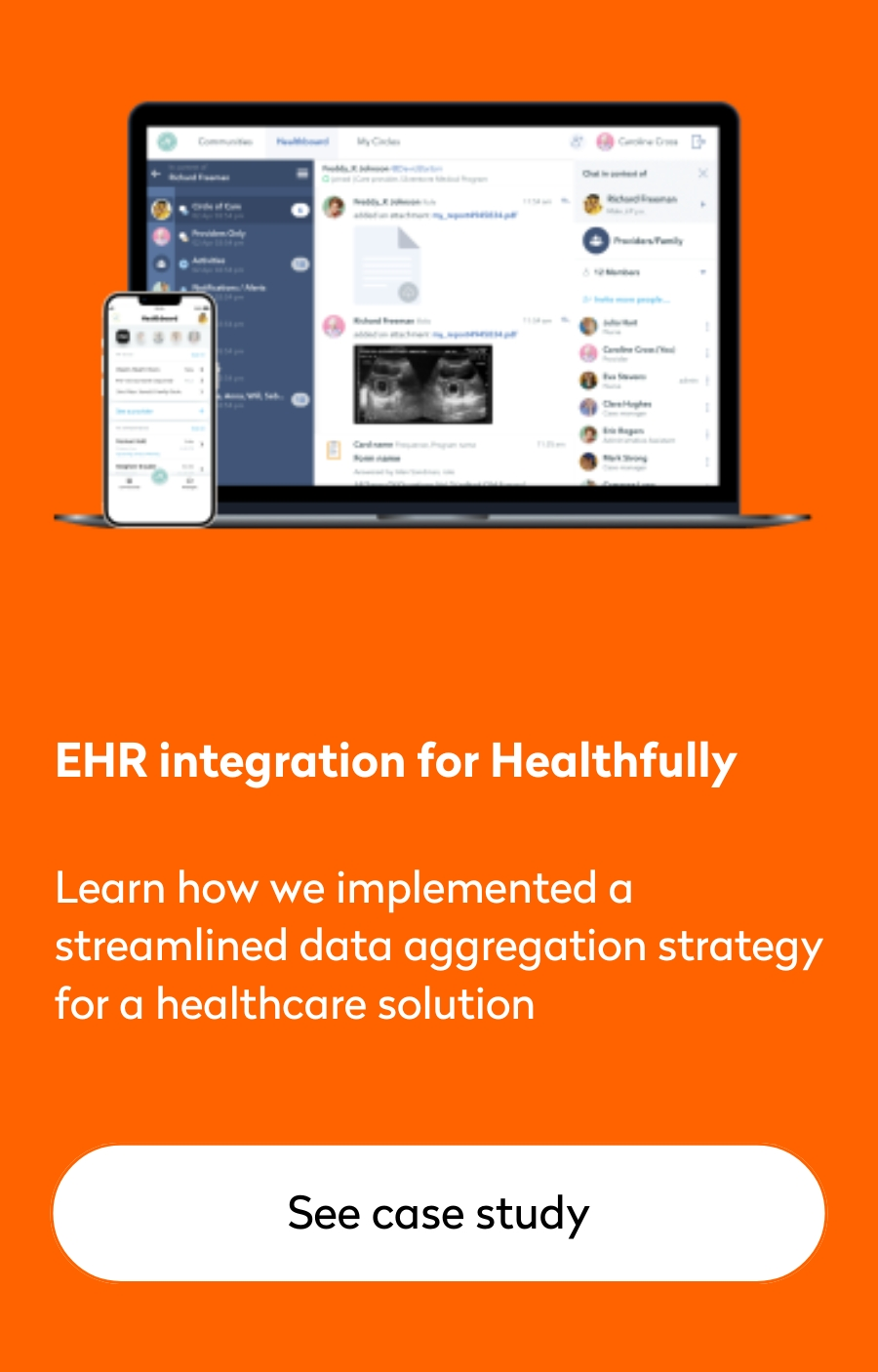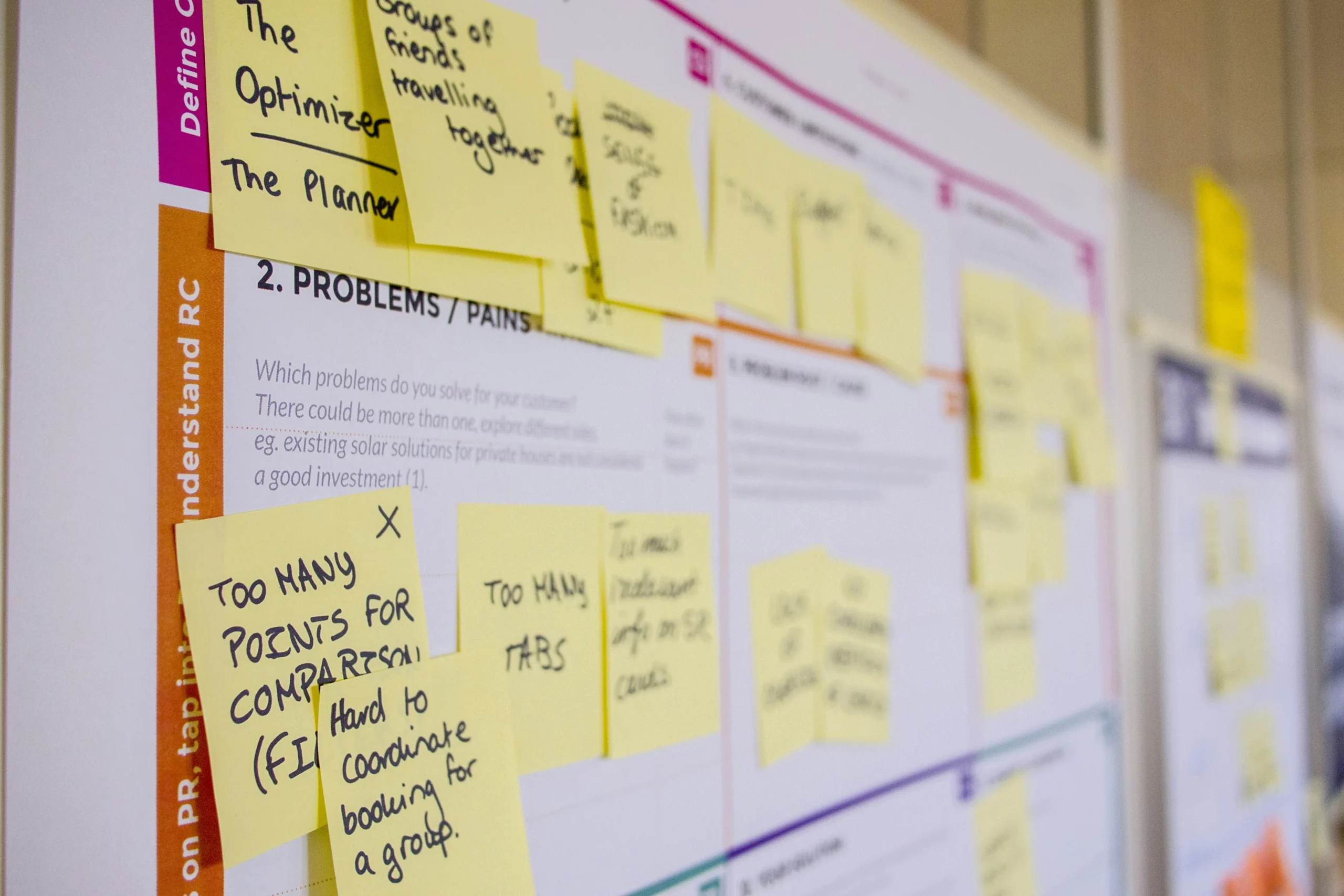
A Complete Guide to Data Modeling with Examples
Summarize:
Do you know how much data your business produces daily? If yes, what is the approximate percentage of all this data you put to good use at your company? To give you a general clue, Immuta surveyed 600 data professionals and revealed that organizations use on average only 58 percent of their data in decision-making. The main culprit is data access. By failing to organize and manage their data properly, businesses miss opportunities to optimize their processes and expenses.
Suppose a company develops new software solutions without ensuring that their business objectives align with data management strategies. In that case, they won’t be able to succeed in the industry and ensure tangible results for the organization, such as increased profits and higher customer retention and attraction.
In this blog post, you will learn about:
- the role data modeling plays in designing a scalable and reliable data architecture for your software system
- what business benefits you can count on if you follow a tried-and-true approach to structuring your data
- common examples and techniques
- tools you can use to speed up modeling
- how Yalantis can help you with efficient modeling
Start building trusting relationships with your data now
Explore our data engineering servicesWhat is data modeling?
A data model is an easy-to-read graph that considers your business requirements and prepares the ground for designing the software application database management system. The data modeling process:
- involves drafting schematic relationships between core business processes and entities that will be the essence of a software application, such as drivers, a vehicle fleet, and orders in a supply chain management software solution
- begins at the requirements analysis stage prior to software architecture development
However, the value of modeling your data is twofold. The more accurate approaches to data modeling of a single application you choose, the better you’ll be able to establish strong data management practices in your organization, as modeling can help you better understand the condition of your cross-functional data assets. According to Piethein Strengholt, author of the book Data Management at Scale, modeling is a crucial area of data management.
Below, you can see the data management pyramid created by Peter Aiken, author of the book Data Management Body of Knowledge. It reflects the typical hierarchy of data management practices in an organization.

Data governance, which includes policies and procedures for maintaining data integrity within the company, is at the base of the pyramid. The second level is about data architecture, data quality, and metadata management, which lay the foundation for the third level, which is devoted to data security, storage, and modeling. In turn, these directly affect data integration and interoperability capabilities, without which such important business initiatives as data analytics and business intelligence won’t function properly.
Later, we cover how you can build a data model and what stages this process involves to help you dive even deeper into data specifics.
Why C-level executives should care about data modeling
Here are a few reasons for you to engage in the modeling process with your data teams:
- Ensure that business processes within your data model align with your current and future goals. This is critical to avoid situations where, for example, the C-suite plans a complete restructuring of your finance department, and the data model for the organization-wide application doesn’t account for this. Plus, if you participate in modeling, you can ensure your application is scalable enough to fit your business expansion strategy and avoid costly changes during software development.
- Better understand data analytics results and insights. If you’re involved in the process of modeling your data at the initial stages of software development, you’ll have a more in-depth understanding of what data aspects and relationships are behind the results of your data analytics tools.
- Efficiently allocate resources and budget to data management practices. If you’re actively involved in every aspect of data management at your organization, including data modeling, you’ll have a clearer perception of how to reasonably allocate resources to foster data initiatives and increase the value of data at your company.
Developing software or managing data without a data model is similar to renovating an apartment without a detailed and accurate design. When remodeling, blueprints indicate where all the outlets will be, for instance, so you have enough outlets in the right places and you don’t have to make costly changes after all the work is done. By the same principle, an efficient and well-thought-out data model identifies all important data assets, establishes clear relationships between them, and helps you minimize costly changes during software development.
To better grasp how data modeling works, let’s cover what key components a data model consists of.
Prepare for streamlined software development with a well-structured data model
Discover data management servicesKey concepts of data modeling
Entities
Entities are a core building block of a data model. They represent real-life objects in the business setting, such as a customer, supplier, order, and delivery in a logistics company or a transaction or loan in a financial organization.
Business entities are pillars for future data analytics, visualizations, and dashboarding, as they define the structure and relationships of the data that drive meaningful insights and support informed decision-making across the organization.
Attributes
Attributes are necessary to provide more details about entities. For instance, a Supplier entity can have such specific properties as address, company name, and phone number.
Attributes are always associated with entity types and can’t exist separately from them. Thus, an attribute Name always refers to a particular entity in the data model and differs depending on the entity type that defines it.
Relationships
Relationships between entities in the data model can fall within the following categories:
- Many-to-many, when multiple elements in one data table refer to many elements in another table. For example, many teams can work on diverse data modeling projects, and projects can involve many team members.
- One-to-many, when there is one parent element connected to many child elements, such as one customer who can place several orders.
- One-to-one, when one data element is linked to only one element in another table. For instance, each product can have only one BOM document.
Benefits of effective data modeling
Data modeling benefits vary depending on the organization’s size and industry, and it’s your go-to for developing scalable and secure applications. At the modeling stage, with the help of diverse tools and best practices, you can:
- lay the foundation for incremental growth of the data that your future application can process while maintaining stable performance
- ensure that your data assets don’t corrupt each other and can be safely integrated with other applications
However, the benefits of modeling don’t stop at improved security and scalability. We can also speak of the following data modeling advantages for your business:
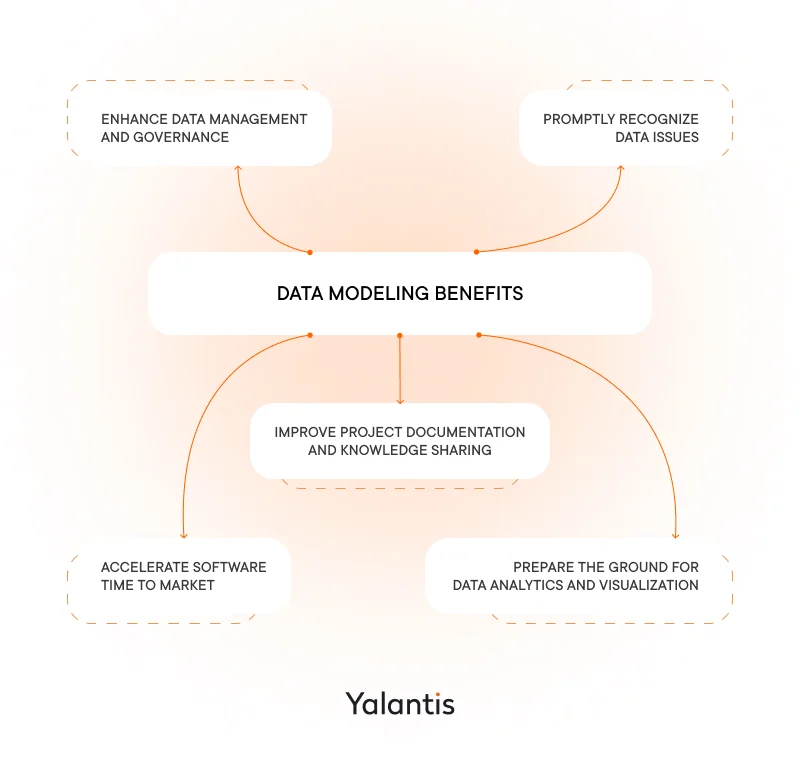
Enhanced data management and data governance
A data model allows organizations to optimally structure the data their software systems produce. A structured data model is the ultimate cure for chaotic and ill-organized data management.
Even though a data model can’t solve every problem, it still helps you be more aware of how your key business entities relate to each other and quickly find out if there are departments or processes in your organization that don’t properly structure the data they use and store.
Awareness of your data assets and their relationship helps you boost your data governance initiatives to maintain proper data integrity, quality, and usability within your organization. To maximize this value, collaborating with a business intelligence company can ensure your modeling efforts directly support broader analytics goals. As a consequence, well-defined data use allows your employees and stakeholders to derive tangible value from various data assets.
Prompt recognition of data issues
With a data model, data architects and teams providing data engineering services can accurately define issues that can potentially complicate or disrupt the software development process, such as inconsistent, inaccurate, duplicate, or low-quality data. Collaborating with an experienced big data service provider can help you address these issues early and ensure smooth integration across systems. This data modeling benefit is especially crucial if a software application needs to be integrated with other corporate systems or third-party solutions, and it’s important to ensure that data exchange between the solutions is accurate, timely, and seamless.
Accelerated time to market for your software solutions
With the help of a well-defined data model, a development team can have a clear understanding of the components that need to be built at each application development stage without frequently referring to business stakeholders.
Improved project documentation and knowledge sharing
To build an efficient data model, you’ll need to actively cooperate with business analysts and technical stakeholders, ensuring that everyone is on the same page. Such alignment at the start of a data modeling project helps you to develop detailed and accurate project documentation to pass the knowledge to other company teams if necessary or use it as the basis for accelerated development of other software systems.
Preparation for data analytics and visualization
Designing a data model is tightly related to business intelligence services and advanced analytics solutions, as it allows business stakeholders to reach a mutual understanding of how data at their organization is organized. And the more accurate the modeling process, the better and more business-oriented the data analytics. When you have a clear understanding of the relationships between your core data assets, you can set the right criteria for business intelligence and advanced analytics tools to generate beneficial insights. Our data science consultants can help you with setting up a proper modeling process that will support advanced analytics in the future.
Now that you have a general idea of what data modeling is and how you can benefit from its development, let’s move to learning more about different types of data models.
Types of data models
There are three data model types: conceptual, logical, and physical. These are called types of data models, but they are also considered stages of data model creation.
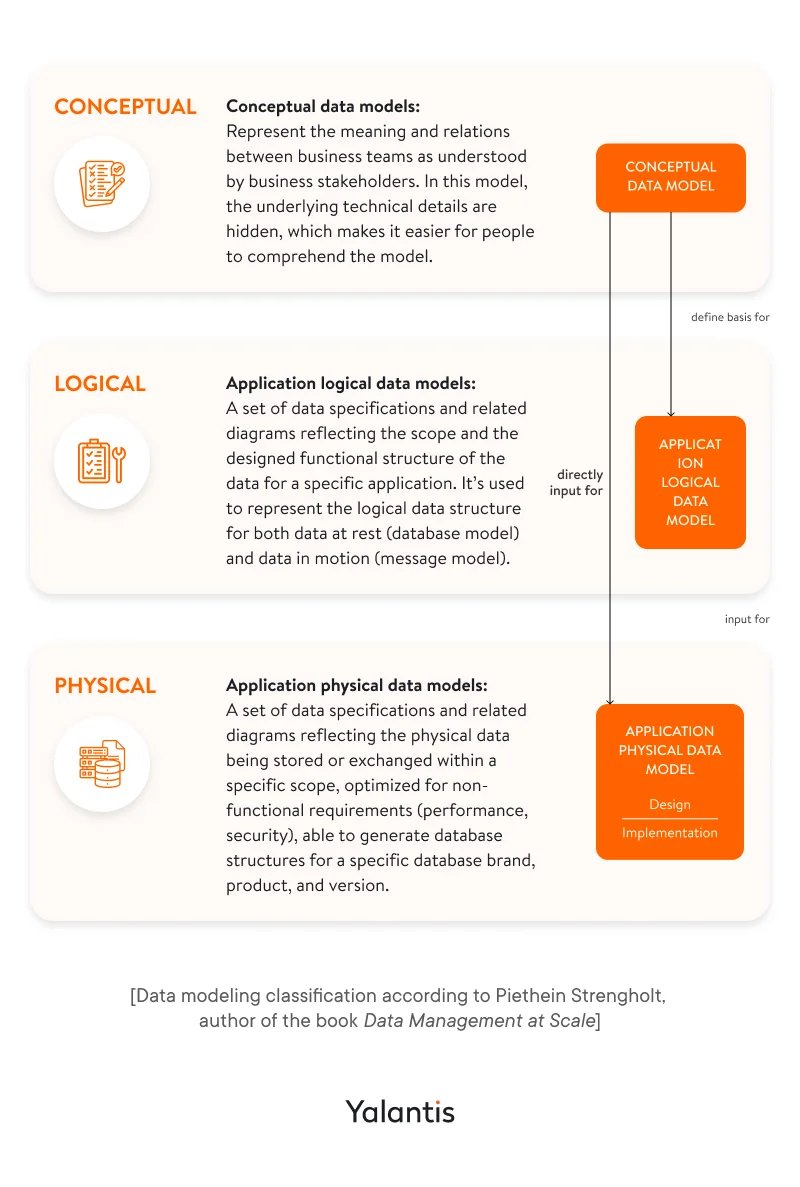
Conceptual data model example
This data modeling type is frequently overlooked and considered insignificant due to its simplistic nature. But conceptual models are exactly what set the tone for the entire modeling process. Developing conceptual data models involves data architects and critical business stakeholders providing high-level business concepts that describe their business processes, relationships between those processes, and the main entities included in them.
For a conceptual data modeling example, let’s take an enterprise that needs to develop an application for their manufacturing department and starts by outlining key concepts for the application’s data model. The concepts could be material, product, bill of materials (BOM), assembly line, employee, supplier, and purchase order. There could be more entities depending on the type of applications, objects, and user roles involved. After defining key entities, the next step is establishing relationships between them.
Logical data model example
Developing a logical model begins with constructing an entity relationship diagram (ERD) that specifies the relationship between entities in the conceptual model in greater detail. Data in a logical data model can already be organized into tables, columns, and rows.
It may seem that thinking through all possible relationships between your data entities is a relatively easy task, but it often takes lots of time to unveil all possible and hidden dependencies. If you want to create a software system that engages two or more departments (such as manufacturing and supply chain), you’ll have to work with many more entities.
And this is when it can get difficult and confusing, especially if certain entities exist across departments. For example, both the manufacturing and supply chain departments may have an order business entity, but it can have a different meaning for each department. For manufacturing, it may refer to an order placed with a supplier company to deliver materials, while for the supply chain department, it may refer to an order placed by a customer.
Physical data model example
A physical data model more closely resembles your application’s database than previous models do, and it’s better not to avoid building it.
To create physical data models, you’ll have to define all columns, tables, relationships, and dependencies between datasets — as well as the context for recording and storing data — allowing data architects to design a complete database for the application. Mainly, a physical model answers the question: How do you implement a database tier in the application architecture?
Creating conceptual, logical, and physical models is only the first step on the way to building a comprehensive data model. In the next section, we’ll learn what’s next.
Popular data modeling techniques
Once a physical data model is created, it’s up to the data architects to combine those tables and columns in a way that corresponds to your business requirements and supports your business operations. Here are a few types of data modeling techniques.
Relational data modeling
In a relational model, data is organized in tables, columns, and rows for efficient and simple retrieval. This type of model fits applications with complex many-to-many relationships. Relational data models, like relational databases, are the most common approach, as they reveal how entities in one table, such as all customer data (customer ID, address, state), relate to data in another table (such as the orders table).
This model uses a range of keys to organize data. Primary keys (PK) indicate what entities one table includes, and foreign keys (FK) are used to show relations between two separate tables.
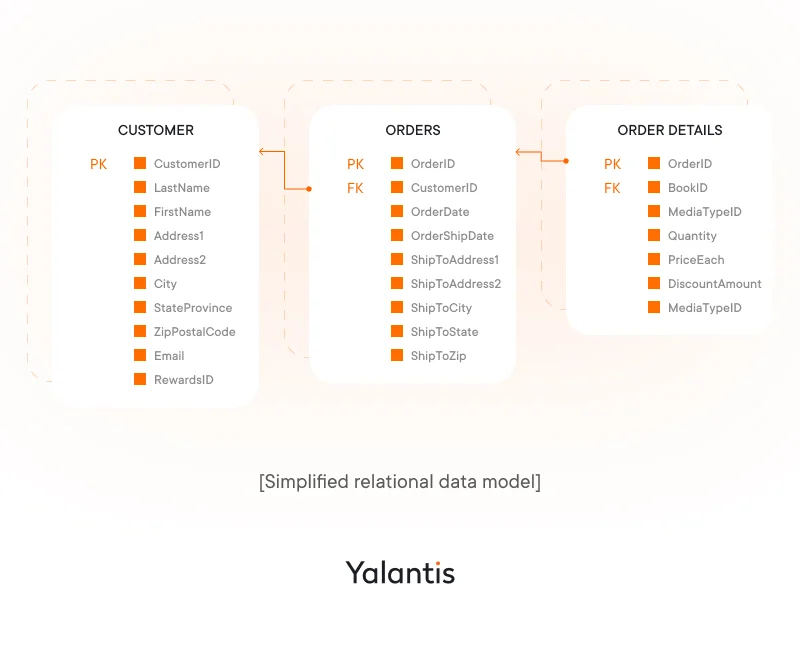
Such common systems as sales management software, supply chain management systems, hospital management systems (HMSs), content management systems (CMSs), and customer relationship management (CRM) systems use a relational data modeling approach for efficient data organization.
Hierarchical data modeling
As the name suggests, a hierarchical data model allows data architects to organize data entities with a parent–child relationship. In such a data model, child nodes can also become parent nodes for their child nodes, but there is always one primary parent node for each set of child nodes. For instance, these data models suit applications that need to include complex organizational structures, such as all company departments, with the board of directors as the entity responsible for all of them. The hierarchical modeling approach also fits when building file systems with strict subordination.
Hierarchical data models in software engineering are considered rather inflexible and have a more difficult procedure for data retrieval than relational data models. If you want a more flexible approach, you can choose a relational model.
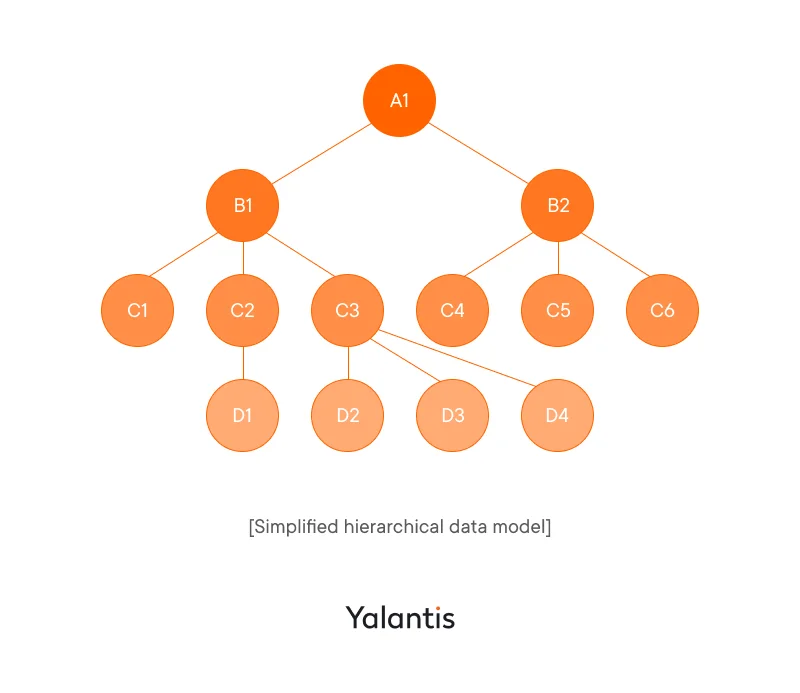
Network data modeling
The third approach we’re going to cover is network data modeling, which is an improvement to rigid hierarchical modeling. Network modeling allows each child branch to have multiple parent nodes. Thus, a one-to-many relationship in a hierarchical model evolves into a many-to-many relationship in a network model.
This type of data model is a high-level graphical representation that consists of boxes and arrows instead of a complex system of tables and columns as in a relational data model. Boxes indicate data records, and arrows indicate relationships between them.
The network data modeling technique is suitable for building a complex organizational structure, indicating more relationships between entities than a hierarchical data model. Such models are simple in nature and easy to read, as they look like diagrams but still lack the flexibility of relational data models.
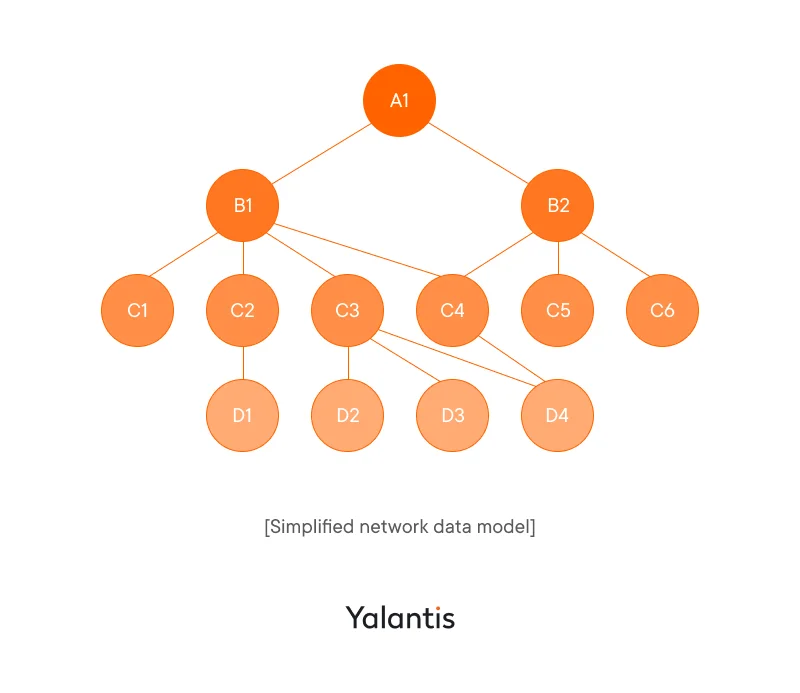
Object-oriented data modeling
This approach is based on the principles of object-oriented programming and works especially well with programming languages such as C++, Java, and Python. However, the major downside is that this modeling technique isn’t equally productive when combined with other programming languages.
The critical principle of object-oriented data modeling is that, instead of defining entities and their unique properties as with relational data models, data architects first define entities that have common properties. Data and real-world actions that can be performed with it (methods) are stored in a single entity, known as an object.
The aim of the object-oriented modeling approach is to save development resources by making a concise data model and reusing its components whenever possible.
Object-oriented modeling can be used in many scenarios, but this approach is particularly beneficial if your application needs to be developed in an object-oriented programming language with a focus on a code-first software development approach (when application code to implement functionality is developed prior to the software architecture and other documentation).

In this section, we’ve covered the most typical data modeling techniques, but there are many more that spring up as a result of evolving digital technologies. Plus, there’s the possibility of building hybrid data models that combine several techniques. Which data model is best for your project depends on the unique functional and non-functional requirements you’ve defined for your software system.
Get step-by-step guidance on how to develop an enterprise data warehouse with data model examples
See the enterprise data warehouse articleReal-world examples of data modeling
Data modeling in a financial company
Developing a detailed data model may take time, but the more prepared you are at the beginning, the quicker your product will be launched (and the more likely you are to avoid cost- and time-intensive workarounds during the software development process). After investing time and resources in data modeling, First Tech Credit Union Bank realized that building a robust data model up front helped reduce the project go-live time and allowed team members to create better business intelligence (BI) reports.
Data modeling in the construction industry
A leader in the construction world, Kiewit, has established a goal of making their business data more visible to be able to act on it and manage it better. They struggled with proliferation of data silos and inconsistent knowledge across business and IT departments. By realizing that data and technology work best when aligned with an organization’s goals and culture, they started developing a conceptual data model.
To create a data model, they interviewed 30 IT specialists and more than 100 business SMEs. And the result was impressive, as they managed to increase cross-company confidence in data and consistency of the data use. For a large company like Kiewit, that’s huge. Plus, they’re now working on fixing data issues that were identified during the building of a data model. Promptly dealing with those issues can help them align their business goals with data even more.
How the data modeling process works
In this section, we summarize the process of building a data model in four critical data modeling steps:
Step 1. Identify data objects. This step requires defining business entities, their attributes or properties, and establishing relationships between them. Relationships between entities are based on the principles of:
- connectivity: one-to-one, one-to-many, many-to-many
- existence dependency, your business rules which emphasize the importance of data modeling relationships, such as an entity order can’t exist without an entity customer
- cardinality, or how many times an entity can appear in the relationship (e.g., you can limit the number of orders a customer can make at a time)
You can conduct this data investigation process with your in-house data team or hire an external data service provider to ensure that you spot all the crucial relationships between all of the essential data elements. It’s possible to start even with a simple table where you list all the critical data objects and describe their relationships.
Step 2. Diagram data objects. Assembling all data objects in a simplified diagram helps to see the big picture of your data relationships and make strides toward building a full-blown dimensional data model. IBM suggests following the E-R (entity relationship) diagram method introduced by C. R. Bachman, which helps to schematically resemble critical relationships between all of your business entities.
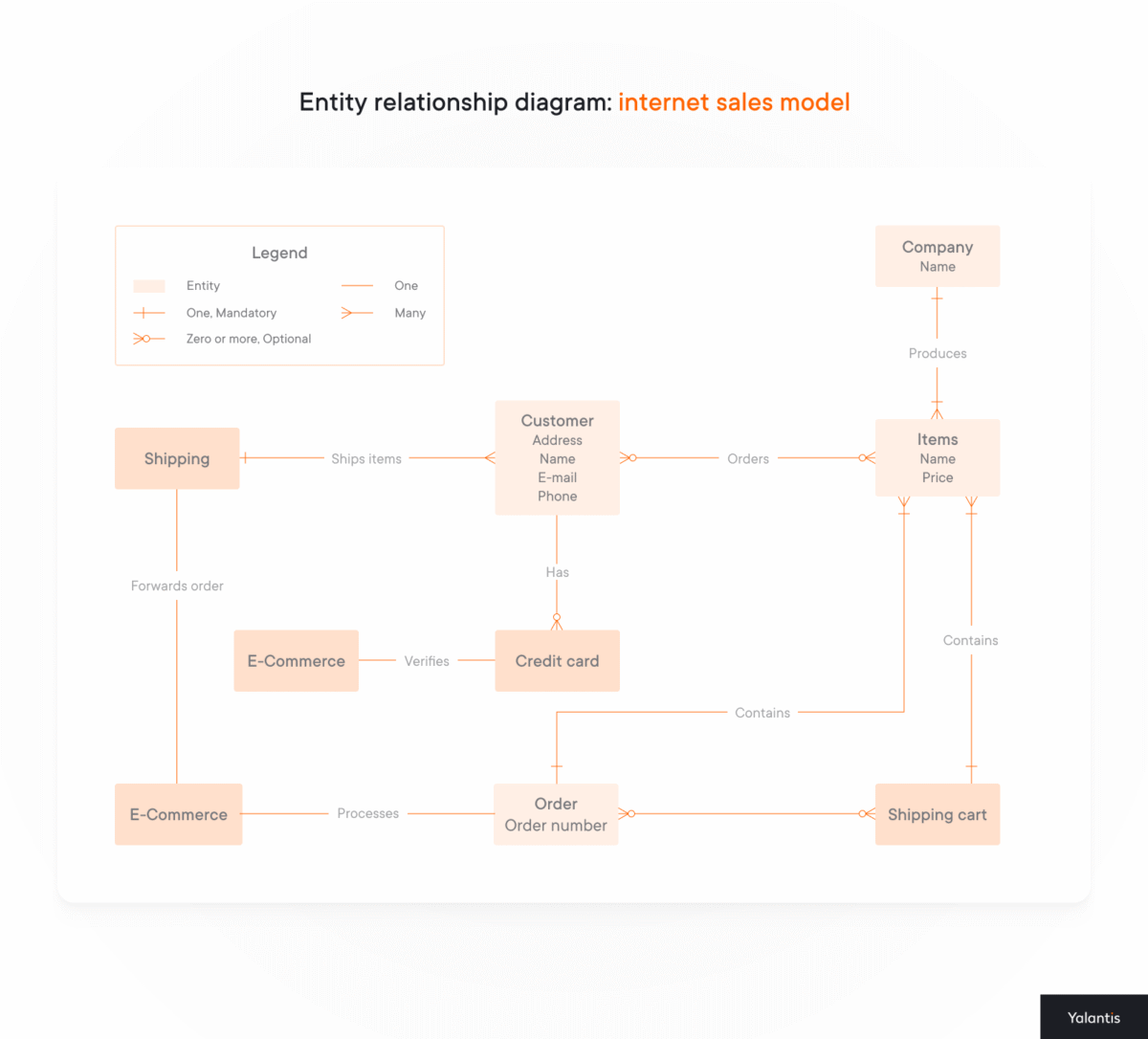
Step 3. Choose a data modeling technique. Depending on the data types your database system will store as well as the intricacy of dependencies between your data objects, choose the right data modeling technique or a combination of several of them. Consult the table below to make the right choice.
|
Criterion |
Relational data modeling |
Hierarchical data modeling |
Network data modeling |
Object-oriented data modeling |
|
Use cases |
Structured data with many-to-many relationships |
Hierarchical, parent-child data with a clear structure |
Complex relationships with multiple parents |
Object-oriented programming languages (e.g., Java, Python) |
|
Complexity of data relationships |
Many-to-many, one-to-many relationships |
Parent-child relationship with a strict hierarchy |
Many-to-many relationships |
Complex data structures, real-world simulations |
|
Performance |
High performance for querying |
Fast for predefined hierarchical data |
Faster for complex data interrelationships |
Can be slower due to additional abstraction |
|
Development stack |
Works well with SQL databases |
Suitable for legacy systems |
Suitable for systems with complex interdependencies |
Best for OOP languages like Java, C++, Python |
|
Integration with external systems |
Seamless integration with BI tools |
Limited integration with external systems |
Useful for connecting various data sources |
Great for integrating into object-oriented frameworks |
Step 4. Implement a data model. Realizing abstract relationships between data objects in the physical world is what constitutes implementing a data model in a database. Building a database based on the data model and integrating it into the application architecture is what makes your software system up and running. That’s the data magic that happens under the hood. Consider also reading our comprehensive article on how to choose a database.
A data model gives you a fundamental understanding of your business dependencies, some of which might be even a surprise for you once brought up in a unified format.
Typical data modeling challenges
- Misalignment between technical and business teams. The most common challenges include miscommunication between key stakeholders, leading to costly workarounds and frequent changes in the data model design. Building a communication plan, including all critical stakeholders, would be an optimal solution to this challenge.
- Overcomplicating a data model. With too many dependencies, relationships, and entities, your data model won’t be efficient. Setting priorities and making tradeoffs where possible is essential. You should analyze the feasibility of your data model during its development to avoid making costly changes at the software architecture level.
- Assumption-driven data modeling. The last mistake is developing a data model based on assumptions in unclear situations. Each decision in modeling your data should be justified and backed up by a clear business need and existing relationships between business entities.
- Ignoring data governance and security. Failing to consider data sensitivity, access rights, or compliance data requirements (e.g., GDPR, HIPAA) at the modeling stage can derail development later.
To help you avoid challenges during data modeling in software engineering, we begin by getting to know your business, its internal processes, and external connections. Then we elicit requirements for your software project, which can include functionality you want your software to have or integrations that are necessary, and compose a comprehensive list of those requirements to hand over to our data modeling experts. The more detailed the requirements you share with us, the more accurate the data model we can build.
Let’s move on to software solutions that can facilitate the modeling process.
Tools that simplify data modeling
The software development market boasts lots of examples of real-time data modeling software and tools that simplify this process, making it more efficient. We’ll discuss five common solutions.
Lucidchart is a visual representation tool suited for building data models and software architecture. It is easy to understand and supports shared real-time collaboration for development teams. Most of its features are available for free, and Lucidchart is a perfect tool for quick data modeling that’s understandable for technical and non-technical stakeholders.
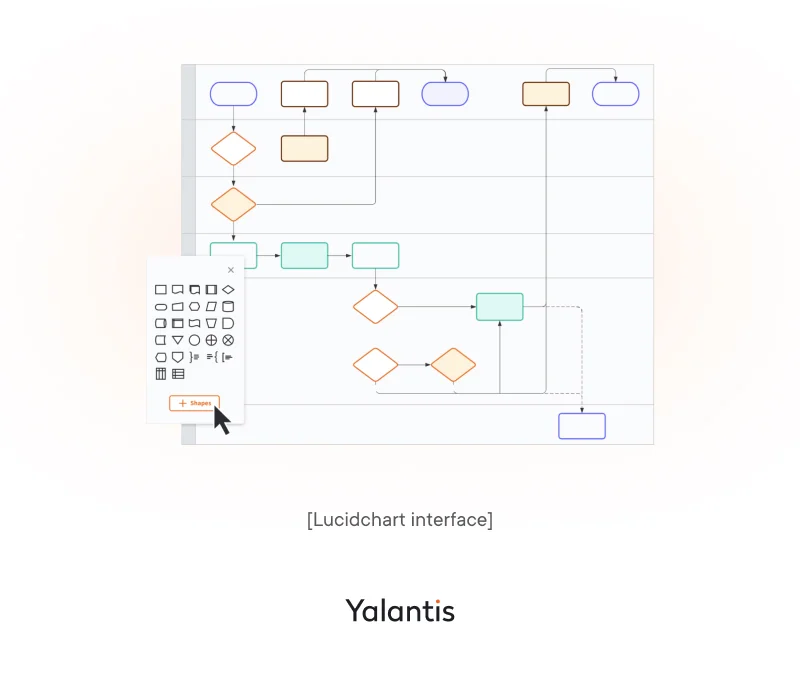
Erwin Data Modeler is the top pick for many companies across diverse industries, as it also includes metadata management, data governance, and data intelligence. In fact, Erwin Data Modeler boasts the widest range of features compared to other tools we list here. Users can easily customize the modeling canvas to their needs and use only those functionalities that suit them.
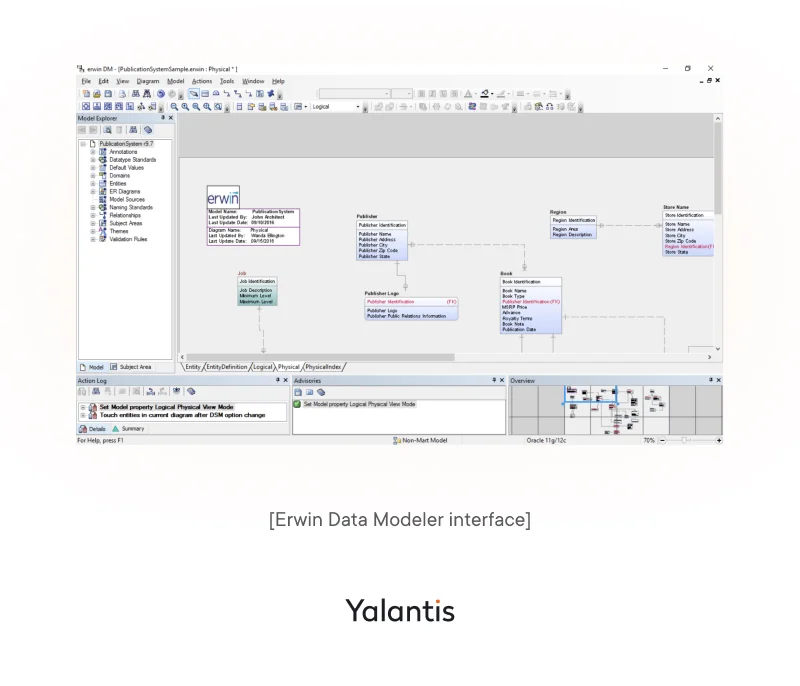
ER/Studio has a convenient collaborative environment and provides lots of scalable opportunities for enterprises of all sizes. ER/Studio offers efficient functionality for data architects, such as forward and reverse engineering. Thus, this tool allows for end-to-end database modeling along with creating a data architecture. ER/Studio also has a wide variety of free tools that help you simplify data modeling without making any financial investment.
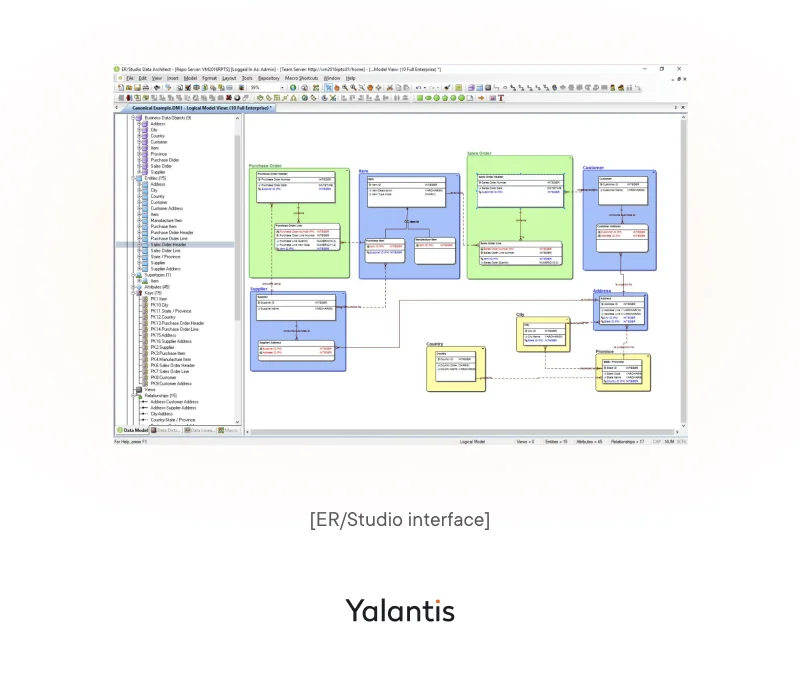
Toad Data Modeler is another convenient tool for data architects, as apart from standard data modeling features, it offers separate solutions to maximize integration with various databases. Toad Modeler also allows end users to generate extensive reports based on data models or data architectures.
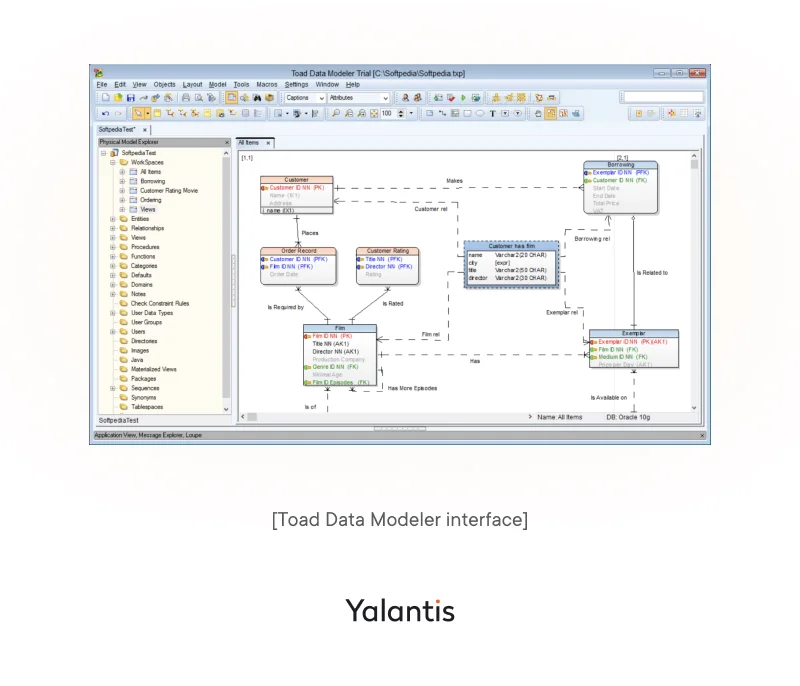
DbSchema is a database design and management tool that connects to many on-premises databases and cloud database solutions. DbSchema offers the possibility to seamlessly build conceptual and logical data models and create comprehensive physical models based on them. This data modeling solution has multiple layouts serving different needs, allowing you to adjust your model in a way that’s convenient for you, such as by creating primary and foreign keys by dragging and dropping or implementing a show/hide feature for column types.
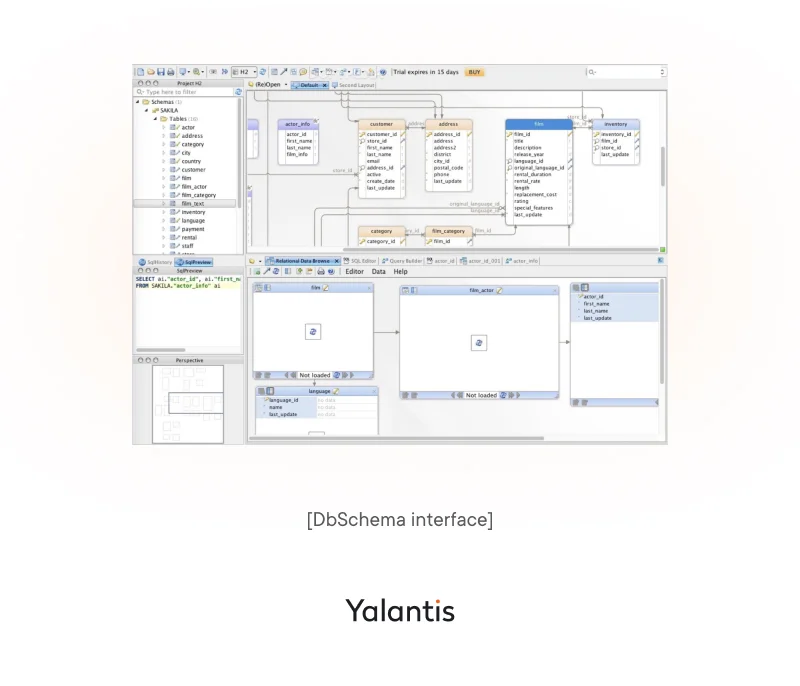
You should discuss types of data modeling solutions with your technical teams to discover the service that best fits your needs, your business model, and the skills of your data architects and database administrators.
If you have a software solution in mind and are unsure where to start, composing a data model can be the perfect way to structure and visualize your abstract ideas and assess their feasibility. Yalantis’ expert team can choose fitting data modeling tools, apply data modeling best practices, and assist you in quickly and effectively achieving your goals with well-organized software solutions.h
Best practices for creating a well-structured data model
We share key best practices for streamlined data modeling that we follow at Yalantis.
Conduct data modeling sessions with all critical stakeholders. Avoid the common mistake of only involving technical experts in the data modeling process. Make sure that all crucial business representatives are also invited to participate. This way, you can ensure that everyone is on the same page before project development starts, resulting in fewer conflicts during the actual development and deployment.
Clearly define your data needs and requirements. Together with technical and non-technical team members, you can discern necessary data elements that will apply to your software solution. In such a manner, you can ensure high application performance and optimal memory use from the outset.
Begin with a conceptual data model. It may be tempting to avoid building a conceptual data model, but you should consider building it right away, as it will help you see the big picture of your core data assets. Once you have a clear vision of what business entities your application should include and how they’re organized and connected with each other, even at the most basic level, you’ll reduce your chances of missing out on important entities and build an end-to-end system that works without disruptions.
Apply data normalization and denormalization approaches when necessary. With the help of data normalization or normalized forms, you can remove redundant or duplicate data right at the data modeling stage, ensuring enhanced application performance and scalability. Normalized forms can be of three types.
|
Form |
What it eliminates |
|
1NF (first normal form) |
Data redundancy |
|
2NF (second normal form) |
Partial dependencies between entities (all attributes of an entity should depend on the primary key) |
|
3NF (third normal form) |
Transitive partial dependencies (when one non-prime attribute of an entity depends on another non-prime attribute, whereas all should depend only on the primary key) |
On the contrary, data denormalization combines data elements into larger units for more efficient data management. It increases data redundancy in exchange for much quicker data queries and retrieval. You can define which approach is the most appropriate for you based on your project requirements.
Get professional help. Cooperating with an experienced data architecture team can help you speed up data modeling, as professionals know the right tools for data collection and classification, such as real-time data streaming, and also how to quickly transform your unique requirements into schematic components of a data model.
Consider Yalantis as a data management and data engineering company to partner with. We provide strategic guidance to help you capitalize on your data and eventually future-proof your business growth.
FAQ
When should a company revisit or redesign its data models?
Whenever your business changes, your data model probably needs to change too. Think product pivots, rapid growth, new integrations, or even a shift in how different teams use data. If your dashboards no longer reflect reality or your development team keeps running into data structure issues, that’s a red flag. Revisit your model early rather than dealing with tech debt later.
What type of data model suits a fast-scaling tech company?
Implement relational data models, as it’s usually the safest way, giving you structure, integrity, and flexibility as you grow. But if your application is built in an object-oriented language and you’re taking a code-first approach, an object-oriented model might save you time and simplify development. Either way, the key is scalability: your model needs to grow with you, not slow you down.
Can data modeling support digital transformation initiatives?
Though not directly, effective data modeling and digital transformation are interconnected. By establishing proper data dependencies and getting to know which data assets are most important for your business growth, you can define what digital solutions and systems can be helpful for you in the future. Just as building a house starts with constructing a foundation first, so most ambitious digital transformation initiatives begin with data engineering and management, to which data modeling also belongs.
Is it worth outsourcing data modeling to a specialized vendor?
If you don’t have strong data architecture skills in-house, then yes. A specialized vendor brings industry best practices, proven tools, and a fresh perspective. They’ll help you avoid common pitfalls and build something that lasts. Plus, it frees up your internal team to focus on product development or strategic initiatives instead of getting buried in schema design.
How does data modeling relate to data governance?
Data modeling is directly related to data management and data governance. If you have data governance procedures in place, such as regular data quality checks, data modeling will go smoothly, without any risks for your business.
Rate this article
4.8/5.0
based on 81 reviews


